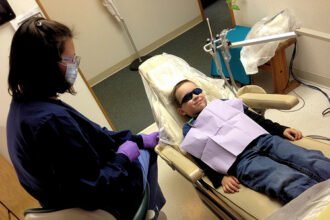
Patricia Salber, MD, MBA, Principal, Zia Healthcare Consultants
I had a chance to “moonlight” in the internal medicine “drop-in” clinic at the Kaiser Medical Center in San Francisco while I was finishing my residency and endocrinology fellowship at UCSF. I was superbly trained in in-patient care and there was no IV or PA line that I couldn’t put in with my eyes closed. I was comfortable taking care of really sick people and thrived on complex, acute cases. I knew how to work up a VIPoma (vanishingly rare endocrine tumor), but, I didn’t know how to treat a paronychia (a skin infection around the nails) and I was bored silly by colds and sore throats – the run of the mill cases that filled up the Kaiser clinic. I used to daydream about building a machine that would grab (gently) the patient by the neck, insert a throat swab, and then spit out a prescription for penicillin. Nine years of training for this! What a waste of all that training!
Well, it turns out the real waste may have been all that training. In a provocative opinion piece in the March 21, 2012 issue of JAMA, Ezekiel Emanuel, MD, PhD, and Victor Fuchs, PhD advocate for shortening medical training by 30%. Currently, they point out, it takes about 14 years after high school to train a subspecialist – 4 years of college, 4 years of medical school, 4 years of residency, and 2 years of fellowship. These doctors are now 32-36 years old and deeply in debt. They often feel that they have to make up for lost time and money, by practicing high volume, procedure-focused medicine. In my opinion, the US approach to medical training has contributed to the mess we are now in.
Emanuel and Fuchs propose that training could be reduced to ten years by shortening pre-medical training to two or three years, shortening medical school to three years and residency to two and fellowship to one. They point out that many residencies and fellowships have substantial time devoted to doing research, but most doctors are never going to do research. Those that are aiming for a career in academic medicine could opt for the extra research training, but those with the goal of a clinical career could skip it. Although anecdotal, it certainly resonates with my experience. I wanted to be a clinical endocrinologist and had little interest in research. Nevertheless, my attendings, giants in endocrinology one and all, were constantly urging me to do a “quick and dirty” little study so that I could get a publication. No wonder our journals are filled with research that really brings no real value to anyone beyond the lengthening of CVs.
So, is there any evidence that reducing time spent in medical training could be done without harming the quality of US physicians? Indeed, there is. But first, as Emanuel and Fuchs point out, over the last few decades, “years of training have been added without evidence that they enhance clinical skills or quality of care.” Conversely, we now have pretty good evidence that shorter training does not lead to a poorer quality graduate or practitioner.
Indeed, most European and British medical schools provide 6 years of training post high school (including both pre-medical and medical training). In addition, according to the authors, more than 30 US medical schools now operate programs that take only 6 or 7 years post-high school. Loftus et al, in a paper published in Teach Learn Med (1997) found no evidence that graduates of the shorter programs perform worse on board exams or as practicing physicians. Further, the authors point to several institutions that have reduced preclinical training time, including University of Pennsylvania and Duke. Again, “there is no evidence that students from either school perform worse on board examinations, placement in residency programs or other significant metrics of competence.”
Emanuel and Fuchs suggest reducing residency training by one year. The third year, they point out is “not essential to ensure competent physicians.” I was on the cusp of the change in duration of Internal Medicine residencies. Starting with my class, IM was changed from 2 years to 3 years. I was offered a slot in the UCSF Endocrine fellowship, so I took a chance that I would be able to waive that final year. I was wrong. I had to go back and put in the third year of Internal Medicine residency after my fellowship – very painful as my interns were now my peers and my 2 years away from general internal medicine rendered me a bit rusty in clinical areas not related to my fellowship. I am pretty sure I wasn’t a better doctor for that extra year, just an older one.
By cutting out or making research years optional, both residencies, such as surgery that require a research year, and fellowships that mostly include a research year could be shortened without degrading outcomes. Docs would go out into practice a bit younger and less in debt.
Now, we all know that change is not easy. Medical educators and organizations that oversee medical curricula, such as the AAMC, have a vested interest in the status quo. It will take a fair amount of work to re-engineer training programs so that all of the essentials are included in a shorter training period. Difficult, yet…but not impossible. Probably a harder nut to crack is how to provide hospital night coverage if training is compacted. But as Emanuel and Fuchs point out, “the education of residents and fellows should not be held hostage to clinical service responsibilities.”
As we continue to debate the provisions of the Accountable Care Act and await the decision of the Supreme Court, I think it is reasonable to include reform of Medical Education in the discussions. Health expenditures account for more than 17% of the US GDP. According to another paper by Victor Fuchs (Major Trends in the US Health Economy since 1950, NEJM, 3/15/2012), we spend more on health care than we do on “all manufacturing or wholesale and retail trade, or finance and insurance, or the combination of agriculture, mining and construction.” And yet, those sectors are also important to the health and well being of our country and its citizens. We need to get a handle on this, and that means, in my mind, putting everything on the table including medical education.
Photo:Levent Konuk/Shutterstock






